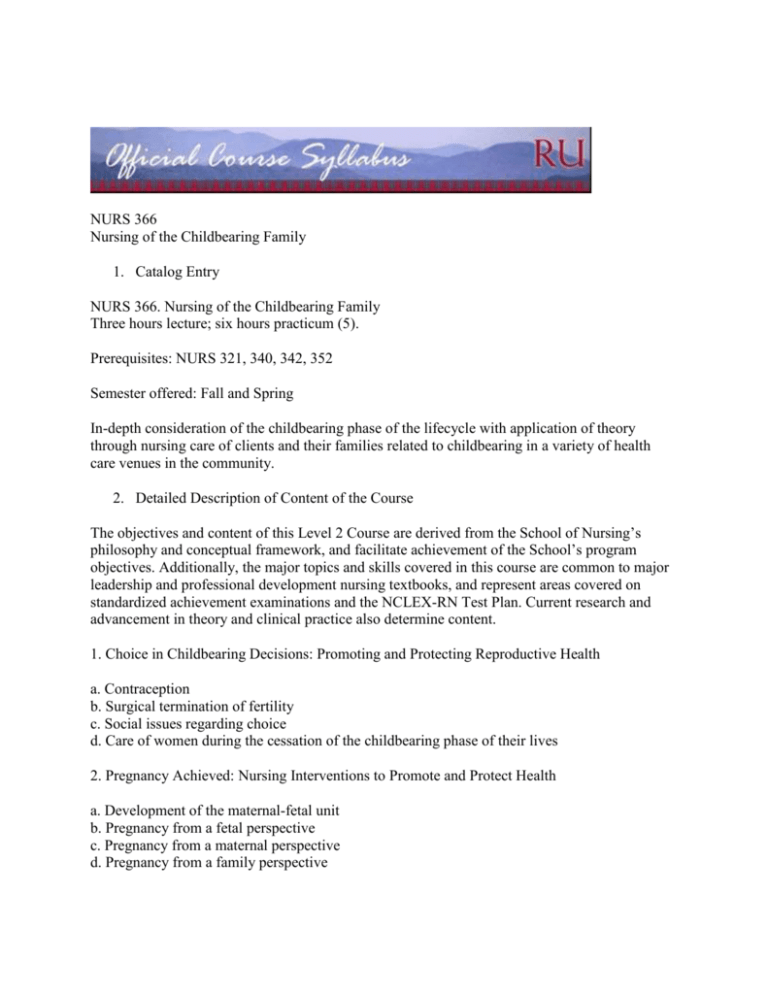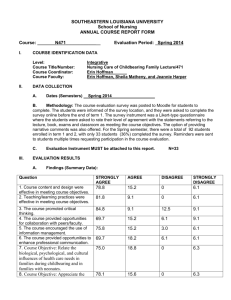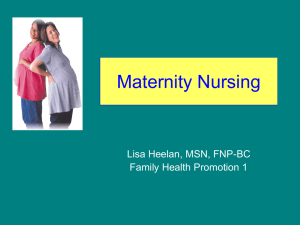NURS 366 Nursing of the Childbearing Family Catalog Entry NURS
advertisement

NURS 366 Nursing of the Childbearing Family 1. Catalog Entry NURS 366. Nursing of the Childbearing Family Three hours lecture; six hours practicum (5). Prerequisites: NURS 321, 340, 342, 352 Semester offered: Fall and Spring In-depth consideration of the childbearing phase of the lifecycle with application of theory through nursing care of clients and their families related to childbearing in a variety of health care venues in the community. 2. Detailed Description of Content of the Course The objectives and content of this Level 2 Course are derived from the School of Nursing’s philosophy and conceptual framework, and facilitate achievement of the School’s program objectives. Additionally, the major topics and skills covered in this course are common to major leadership and professional development nursing textbooks, and represent areas covered on standardized achievement examinations and the NCLEX-RN Test Plan. Current research and advancement in theory and clinical practice also determine content. 1. Choice in Childbearing Decisions: Promoting and Protecting Reproductive Health a. Contraception b. Surgical termination of fertility c. Social issues regarding choice d. Care of women during the cessation of the childbearing phase of their lives 2. Pregnancy Achieved: Nursing Interventions to Promote and Protect Health a. Development of the maternal-fetal unit b. Pregnancy from a fetal perspective c. Pregnancy from a maternal perspective d. Pregnancy from a family perspective 3. Childbirth a. Labor and birth b. Nursing measures to promote and protect health c. Immediate care of the newborn 4. Parents and Newborn Postpartum: Promoting and Protecting Health a. The developing family b. The newborn c. Maternal recovery from pregnancy and birth 5. Childbearing Family: Restoring Health a. Reproductive risk: Achieving pregnancy b. Reproductive risk: Pregnancy c. Reproductive risk: Labor and Delivery d. Reproductive risk: Postpartum e. Reproductive risk: The sick newborn 3. Detailed Description of Conduct of Course The following teaching strategies will be employed: Lectures, discussion, multimedia, case studies, and guided clinical practice. 4. Goals and Objectives of the Course Upon successful completion of the course, the student will be able to: 1. Apply skills basic to the nursing process interdependently, working in partnership with individuals and families. 2. Adhere to AWOHNN Standards of Maternity Nursing Practice, accepting individual responsibility for nursing interventions. 3. Demonstrate increasing skill in the use of health care and information technology in the care of newborns and their parents/families. 4. Use basic skills of critical thinking in nursing care of the childbearing family. 5. Demonstrate increasing competency in therapeutic nursing interventions in the care of women and their families related to childbearing. 6. Refine/utilize effective written, oral, and nonverbal communication skills relevant to the care of childbearing families. 7. Demonstrate interdependent ethical decision making skills in care of the childbearing family. 8. Demonstrate appreciation of cultural variations and diversity of childbearing clients and their families. 9. Demonstrate growing self-directed learning and personal/professional development. 10. Accept accountability for own nursing actions, applying basic leadership skill in providing professional care to childbearing clients and their families. 11. Examine legislative and policy issues related to health care provided to childbearing families. 12. Use the nursing roles of educator, collaborator, consumer of research, and advocate in providing care to childbearing families. 5. Assessment Measures May include: Exams; Quizzes Paper Project, Individual or Group Care Plan Oral Presentations Class Participation The course grade is determined by an evaluation of the extent to which the student meets the stated course objectives. Students must have a minimum of 75% (“C”) in theory, measured through testing. Other written or class participation work will be included in the final grade after the minimum 75% (“C”) has been attained through testing. Final Grades are a combination of at least 75% (“C”) on both theory and clinical/lab components. Clinical/lab performance must be satisfactory to pass the course. 6. Other Course Information Honor Code: By accepting admission to Radford University, each student makes a commitment to understand, support, and abide by the University Honor Code without compromise or exception. Violations of academic integrity will not be tolerated. This class will be conducted in strict observance of the Honor Code. Refer to your Student Handbook for details. Students with Disabilities: If you are seeking classroom accommodations under the Americans With Disabilities Act, you are required to register with the Disability Resource Office (DRO). The DRO is located in Room 32, Tyler Hall, telephone 540-831-6350. To receive academic accommodations for this class, please obtain the proper DRO forms and meet with me no later than the second week of the semester. Attendance: For Attendance policies and other course-related requirements, see School of Nursing Undergraduate Student Handbook and Course Description. 7. Review and Approval Date Action Reviewed by April 2006 Undergraduate Curriculum Marcella Griggs, Director NURS 366 Nursing of the Childbearing Family 1. Catalog Entry NURS 366. Nursing of the Childbearing Family Three hours lecture; six hours practicum (5). Prerequisites: NURS 340, 341, 342, 352 Semester offered: Fall and Spring In-depth consideration of the childbearing phase of the lifecycle with application of theory through nursing care of clients and their families related to childbearing in a variety of health care venues in the community. 2. Detailed Description of Content of the Course The objectives and content of this Level 2 Course are derived from the School of Nursing’s philosophy and conceptual framework, and facilitate achievement of the School’s program objectives as well as the Essentials of Baccalaureate Education (AACN). Additionally, the major topics and skills covered in this course are common to major leadership and professional development nursing textbooks, and represent areas covered on standardized achievement examinations and the NCLEX-RN Test Plan. Current research and advancement in theory and clinical practice also determine content. 1. Choice in Childbearing Decisions: Promoting and Protecting Reproductive Health a. Contraception b. Termination of fertility c. Social issues regarding choice d. Care of women during the cessation of the childbearing phase of their lives 2. Pregnancy Achieved: Nursing Interventions to Promote and Protect Health a. Development of the maternal-fetal unit b. Pregnancy from a fetal perspective c. Pregnancy from a maternal perspective d. Pregnancy from a family perspective 3. Childbirth a. Labor and birth b. Nursing measures to promote and protect health c. Immediate care of the newborn 4. Parents and Newborn Postpartum: Promoting and Protecting Health a. The developing family b. The newborn c. Maternal recovery from pregnancy and birth d. Prevention, identification and reporting of abuse and neglect within families. 5. Childbearing Family: Restoring Health a. Reproductive risk: Achieving pregnancy b. Reproductive risk: Pregnancy c. Reproductive risk: Labor and Delivery d. Reproductive risk: Postpartum e. Reproductive risk: The sick newborn 3. Detailed Description of Conduct of Course The following teaching strategies will be employed but not limited to: Lectures, discussion, multimedia, case studies, and guided clinical practice. 4. Goals and Objectives of the Course Upon successful completion of the course, the student will be able to: 1. Apply knowledge of historical, social and cultural factors to the care of diverse populations in maternal/newborn area. 2. Provide nursing care of mothers and newborns based on evidence that contributes to safe and high quality patient outcomes within healthcare and assumes accountability for personal and professional behaviors. 3. Demonstrate an understanding of the basic elements of the research process and models for applying evidence to maternal newborn clinical practice. 4. Demonstrate skill in using patient care technologies, information systems and communication devices that support safe maternal newborn nursing practice. 5. Apply knowledge of legislative and regulatory processes within the health care delivery system in the provision of safe, high-quality, and cost effective nursing care with maternal newborn populations. 6. Utilize written, verbal, nonverbal and emerging technology methods to communicate effectively with all members of the healthcare team, including the patient and the patient’s support network and assumes accountability. 7. Utilize scientific principles of nursing knowledge in an interdependent manner when working in collaboration with individuals and families to promote health, manage illness and disease, and care for emerging families. 8. Demonstrate ethical decision-making in an interdependent manner in ethical dilemmas faced by individuals and families and assumes accountability for personal and professional behaviors. 9. Demonstrate the professional standards of moral, ethical, and legal conduct. Adheres to AWHONN Standards of Maternity Nursing Practice, accepting individual responsibility for nursing interventions. 10. Delivers compassionate, patient centered, evidenced based care that respects patients and family preferences. 5. Assessment Measures May include but not limited to: Exams; Quizzes Comprehensive Clinical Logs Oral Presentations Class Participation The course grade is determined by an evaluation of the extent to which the student meets the stated course objectives. Students must have a minimum of 75% (“C”) in theory, measured through testing. Other written or class participation work will be included in the final grade after the minimum 75% (“C”) has been attained through testing. Final Grades are a combination of at least 75% (“C”) on both theory and clinical/lab components. Clinical/lab performance must be satisfactory to pass the course. 6. Other Course Information By accepting admission to Radford University, each student makes a commitment to understand, support, and abide by the University Honor Code without compromise or exception. Violations of academic integrity will not be tolerated. This class will be conducted in strict observance of the Honor Code. Refer to your Student Handbook for details. The Waldron College has distinct expectations of students that are in addition to those outlined in the Radford University Student Handbook. These standards are aligned with students’ abilities to become effective health and human service professionals and are provided so that students and faculty can be clear about expectations and procedures to address practice performance. The ultimate goal of the standards is to help students become successful health and human service professionals. All students are expected to read and sign the Waldron College Standards for Professional Practice Education. Students are expected to review these standards every semester. Students with Disabilities: If you are seeking classroom accommodations under the Americans With Disabilities Act, you are required to register with the Disability Resource Office (DRO). The DRO is located in Room 32, Tyler Hall, telephone 540-831-6350, 540831-6350. To receive academic accommodations for this class, please obtain the proper DRO forms and meet with me no later than the second week of the semester. Attendance: For Attendance policies and other course-related requirements, see School of Nursing Undergraduate Student Handbook and Course Description. 7. Review and Approval Reviewed February 2011, Kim Carter, Director







